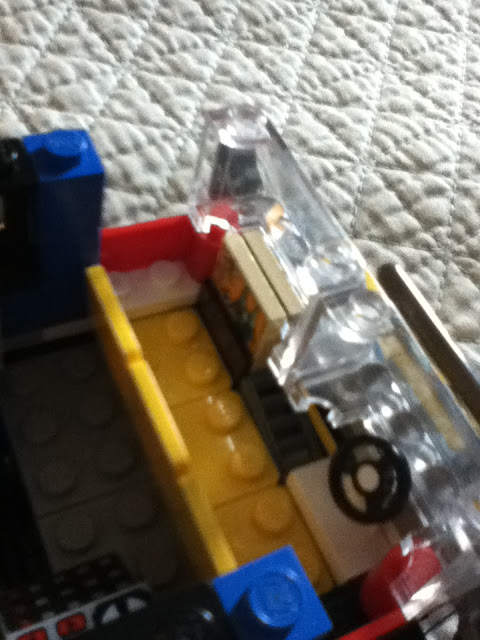The Volkswagen Bus has long been a favorite vehicle of mine. The apocalypse has been a favorite theme of mine. I thought one day that I would combine those two ideas. Must I really explain why? No. Let's talk about the Lego machine.
Since the vehicle is covered with apocalyptic extras, we can cover this machine one piece at a time.
With the pieces I had at my disposal, I focused on the structure of the front, as that is the most distinguishable part of the VW Bus. I used the side-to-side clips to attach side-mirrors, two 4-wide windscreen pieces for the windshield. I put a jail-window for a metal grate over the driver-side windscreen. As usual, I made the vehicle 8-studs-wide. For lack of a VW emblem, I used a simple 4x4 circle plate.
The back view provides us with a better glimpse of the duallies, as well as the doors for the engine area (oh yes, there's an engine in there). The back windows are covered up from the inside (this is the apocalypse after all.
It's hard to get a good image of the engine, because of the shadows in the engine bay (using the flash illuminated everything but the engine area as well). Like the actual VW Bus, the engine is in the back, under the backseat. Unlike the stock versions, this one is decked out differently on the inside (but more on that later).
On the right side of the vehicle, we can see that the rear-side windows are black mesh (to protect the occupants from shrapnel, zombies, Jehovah's Witnesses, etc). The metal grating over the side door doubles as a ladder to get to the roof.
The roof has a solar power sphere, which helps generate power for the appliances (we'll get to the interior in just a minute, or hour if you read slowly) and electricity in the vehicle. There are also ares to store luggage, tools, and weapons. Up on the top-center is a mounted crossbow. It turns out these are great weapons in the apocalypse.
The metal ladder/grating also folds down to access the door, and it doubles as a bridge, which is handy in almost no circumstance except for when you park next to a 3 foot high curb or a small river of lava. Still, it's good to be prepared.
As an extra security mechanism, here is the sign: "Keep Out." That'll stop those murdering raiders and starving walkers. We also get a glance inside, can kind of see the sink area, and so we begin our tour of the interior.
As funny as it may look, having the roof hinge upwards allows easier access to the inside. Now, some VW Buses just had bench seats. But a lot of them were for hippies who liked to go live in the woods and smoke hookahs and stuff. So they were designed more like recreational vehicles in the inside. Since it's the apocalypse, having something to live in comfortably seems the most rational.
From this view we can see the sink a little bit, a stove top, a computer navigation machine, and a backpack. Behind the backpack are cupboards for storage. The glass pane underneath the backpack covers the engine while taking up the least amount of space in the inside. I know there are pieces of this nature that are colored, and once I get some, I can replace that glass. In the meantime, it offers a nice view of the engine.
Above the sink and stove-top, you can see that there is a hinge piece and a sideways brick, and are probably wondering what it is. Well that, my friend, is the bottom of a fold-down bed.
Here is that bed folded down. There is a little pillow on it, and whatnot. Good for storage, for saving room in the inside while not sleeping.
Up front is a bench seat, for squishing up next to your girlfriend on long, romantic evenings, running (driving?) for your gritty, unshowered lives from the murderous scum that have overridden the earth. The dashboard in front of the passenger side has a slot for maps, in case GPS satellites are no longer functioning. So whoohoo, I hope your girl can navigate like they had to in the old days.
It is entirely probable that I had way too much fun building this machine, but ah well, such is the life of a child-at-heart. Coming soon is the other VW Bus that I built for my girlfriend (right now it's white, but I might change that.)























